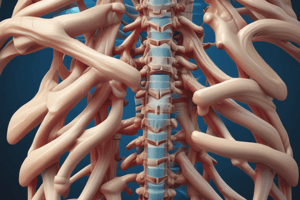Podcast
Questions and Answers
Apophyseal injuries commonly occur in adults because the tendons are stronger than the secondary ossification centres.
Apophyseal injuries commonly occur in adults because the tendons are stronger than the secondary ossification centres.
False (B)
Avulsion fractures only occur in adolescents and not in children or adults.
Avulsion fractures only occur in adolescents and not in children or adults.
False (B)
The lesser trochanter avulsion in an adult typically indicates a musculoskeletal injury.
The lesser trochanter avulsion in an adult typically indicates a musculoskeletal injury.
False (B)
The ischial tuberosity is associated with the hamstrings muscle.
The ischial tuberosity is associated with the hamstrings muscle.
Avulsion fractures of the pelvis occur specifically at secondary ossification centres.
Avulsion fractures of the pelvis occur specifically at secondary ossification centres.
Flashcards
Avulsion Fracture
Avulsion Fracture
A break in a bone where a tendon or ligament pulls a piece of bone away.
Apophyseal Injury
Apophyseal Injury
A break in the secondary ossification center of a bone, occurring at the growth plate.
ASIS (Anterior Superior Iliac Spine)
ASIS (Anterior Superior Iliac Spine)
The bony attachment point at the front of the iliac crest. The Sartorius muscle originates here.
Lesser Trochanter
Lesser Trochanter
Signup and view all the flashcards
Lesser Trochanter Avulsion in Adults
Lesser Trochanter Avulsion in Adults
Signup and view all the flashcards
Study Notes
Apophyseal Injuries (Avulsion Fractures)
- Common in adolescents due to stronger tendons compared to developing secondary ossification centres.
- Occur specifically in the unfused skeleton.
- Other avulsion fractures happen in children and adults, but those in the table are in secondary ossification centres around the pelvis.
- Lesser trochanter avulsion in adults suggests a possible metastasis, not a musculoskeletal injury.
Apophyseal Injury Locations and Associated Muscles
- ASIS (Anterior Superior Iliac Spine): Sartorius muscle
- AIIS (Anterior Inferior Iliac Spine): Rectus femoris (straight head)
- Pubic ramus: Adductors and gracilis muscles
- Lesser trochanter: Iliopsoas muscle
- Ischial tuberosity: Hamstring muscles
Studying That Suits You
Use AI to generate personalized quizzes and flashcards to suit your learning preferences.

